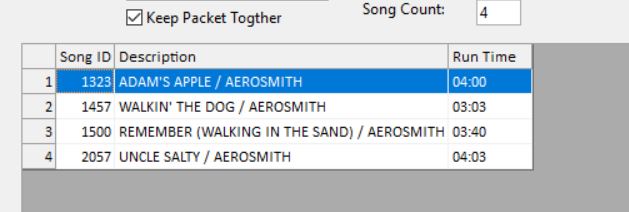MusicMaster Blog
Packets: Three Different Ways to Manage Challenges Within Your Library posted on May 6th, 2019
By Brian Wheeler
Once in a while, I’ll have a couple back-to-back phone calls from MusicMaster users that will give me an idea for blog content. This blog is a result of such a phenomenon.
The first call was from a programmer who played a good amount of gold that were regional hits and wanted to manage those tracks so they didn’t have quite the same impact as the regular gold in his categories. With a couple of tweaks we’d set up two kinds of packets for him.
The first kind of packets we set up were standard packets for his depth cuts from core regional artists. These were all ‘bubbling under’ tracks that were still pretty big regionally but didn’t do much nationally. He wanted them to continue to get exposure but at a reduced level from the rest of the category. We talked about how the size of the packets determined their exposure. A packet of 2 splits the exposure in half. A packet of 3 reduces exposure by 66%, etc. It’s that pesky math, always creeping into programming.
Here’s a sample of what his standard packets would look like:
For the songs we were packeting, a standard packet was going to get the job done. These songs didn’t have much that was going to prevent them from scheduling as far as rules go. So when that packet came up in the schedule order, the song at the top of the packet was scheduled, then sent back to the bottom of the packet list and the next song in the packet would be considered the next time around. It was perfect.
But then he had some one-hit wonders that he also wanted to control with packets, and some of those songs regularly challenged his rules. He found that he was getting unscheduled positions when he’d encounter these packets and it was causing him to rethink the packet concept. I proposed the diggable packet, which allowed MusicMaster to dig through the packet to find a song that satisfied his rules. He loved that idea. His minimum rest rule would prevent these songs from playing too frequently, but if he ran into the rare one-hit wonder within that packet that violated the rule it wouldn’t prevent the scheduler from finding a song that DIDN’T violate. He was reducing his exposure to these songs and still able to focus on the other aspects of his programming rather than micromanage a handful of one-hit wonders that he rarely wanted to appear.
The next call I got was from a programmer who wanted to play live versions of a particular song, but in a reduced ratio to the regular recording of the song. She didn’t have many live versions that she wanted to play, but enough where she felt there needed to be an element of control. I proposed the weighted packet. She could place the live version in a packet with the regular version, then control the ratio to regular plays to live plays by placing a weight on the regular version. In some situations, she applied a ‘2’ to the regular version when the live version was a hit, but she still wanted the regular version to play twice for every single live version play. Then on a few others where the live version wasn’t a hit and she just wanted to add flavor, she applied a ‘3’ or a ‘4’ to the regular version. This meant the regular version would play that many times before the live version would come up for airplay.
Control achieved. She is still playing the live version, but at a reduced rate and very much within her comfort zone.
If you’ve not created a packet before or would like a refresher course, here’s a brief video demonstrating creation of packets.
If you have any questions, please reach out to your Music Scheduling Consultant for assistance.




